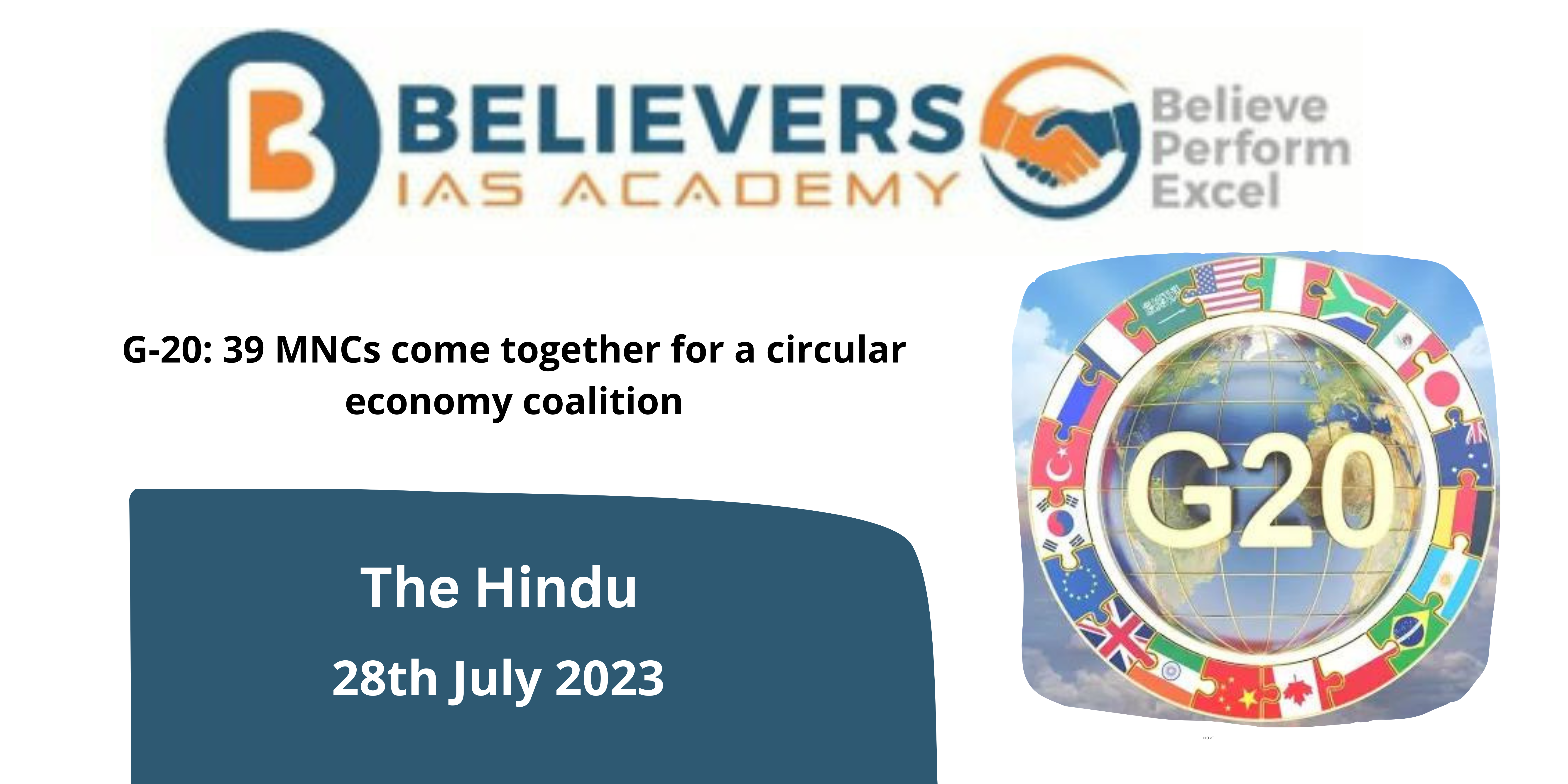G-20: 39 MNCs come together for a circular economy coalition
Context
As stated by Union Minister Bhupender Yadav at the Resource Efficiency Circular Economy Industry Coalition (RECEIC) launch on the sidelines of the fourth G-20 Environment and Climate Sustainability Working Group (ECSWG) and Environment and Climate Ministers’ meeting in Chennai on Thursday, adopting a circular economy model enables transition from the linear “take-make-waste” paradigm and embrace a more sustainable and regenerative approach.
What is Circular Economy Model?
- Model of Production and Consumption: The circular economy is a resource-efficient economic model that attempts to cut waste and usage of limited resources to a minimum. It emphasizes eliminating waste and pollution through design, extending the useful life of products and materials, and renewing natural systems.
- Key Ideas: The circular economy is based on ideas like lending, sharing, reusing, mending, renovating, and recycling. These methods encourage a production and consumption strategy that is more environmentally responsible and sustainable.
- Extending Product Lifecycles: The circular economy aims to increase the lifespan of items through a variety of strategies, as opposed to adhering to the conventional linear model (take-make-consume-throw-away). Products can be kept functional and in use for longer periods of time by repairing and refurbishing them.
- Recycling and Reuse: The circular economy places a strong emphasis on recycling and reusing items’ materials to make new ones once they have served their purpose. This lessens the need to mine new raw materials, conserves resources, and has a little negative impact on the environment.
- Reduced Waste: The circular economy tries to reduce waste generation, particularly the amount of garbage that ends up in landfills or incinerators, by focusing on prolonging product lifecycles and encouraging recycling and reuse.
- Combating Planned Obsolescence: Planned obsolescence is the practice of purposely designing things with a short lifespan so that buyers will replace them frequently. The circular economy discourages this approach since it is inimical to the objectives of increasing product lifespans and lowering waste.
- Importance of sustainable Design: The circular economy depends heavily on sustainable design, which is important. Durable, repairable, and simple to deconstruct for recycling are all features that are built into products. The use of products for as long as possible is ensured by this design strategy.
What is Resource Efficiency Circular Economy Industry Coalition (RECEIC)?
- 39 multinational businesses (MNCs) from various industries, including steel, FMCG (Fast-Moving Consumer Goods), and electronics have established the RECEIC coalition.
- The coalition is dedicated to implementing the circular economy and resource efficiency concepts to address environmental issues brought on by various waste kinds, such as plastics, microplastics, e-waste, and chemical waste.
- International Cooperation: In Chennai, on the eve of the Environment and Climate Ministers’ conference and the fourth meeting of the G-20 Environment and Climate Sustainability Working Group (ECSWG), RECEIC was officially launched. In an example of international cooperation for sustainability, ministers from seven nations, including Mauritius, Denmark, Italy, Canada, the UAE, France, and the European Union, were present.
- Government’s Function: The government will serve as a supportive member of the coalition, which will be led by business. With this strategy, the private sector adopts sustainable practices voluntarily, while the government merely supports and facilitates these efforts through regulatory and legislative frameworks.
How is this grouping going to help is reducing waste management in India?
- Plastic Waste in India: India faces significant challenges regarding plastic waste. In 2021-22, approximately 41 lakh tonnes of plastic waste were generated in the country. To address this issue, the government introduced Extended Producers’ Responsibility (EPR) guidelines through the Plastic Waste Management (Amendment) Rules, 2022.
- Extended Producers’ Responsibility (EPR): EPR guidelines hold producers, importers, and brand owners accountable for the post-consumer stage of their products, including their end-of-life waste. This incentivizes them to manage and recycle their products responsibly and reduce their environmental impact.
- EPR Certificates: Plastic waste processors produced 2.6 million tonnes of EPR certifications in accordance to the EPR recommendations. The commitment made by manufacturers and brand owners to recycle their plastic trash is shown in these certificates.
- Purchase of EPR Certificates: In order to fulfill their 2022–23 commitments, producers, importers, and brand owners (PIBOs) purchased approximately 1.51 million tonnes of these EPR certificates. This displays their dedication to carrying out their obligations under the EPR regulations.
- G-20 ECSWG: The G-20 Environment and Climate Sustainability Working Group (ECSWG) has been actively promoting international cooperation to achieve a sustainable future and engaging in talks on environmental challenges.
- Future Sustainability: Discussions at conferences like the ECSWG and initiatives like RECEIC are essential in accelerating the transition of the world to a more sustainable and circular economy. These initiatives help to lessen environmental impact, save resources, and create a more resilient and sustainable world for the future by bringing together governments, industry, and stakeholders.
Overall, establishing a more sustainable and environmentally friendly future will require taking important initiatives, such as those demonstrated at the G-20 ECSWG and the willingness of multinational firms to implement circular economy principles through RECEIC.





